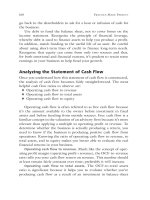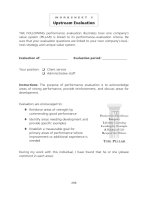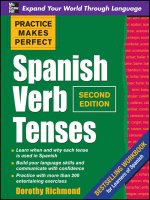practice makes perfect spanish sentence builder
Bạn đang xem bản rút gọn của tài liệu. Xem và tải ngay bản đầy đủ của tài liệu tại đây (2.3 MB, 224 trang )
PRACTICE
MAKES
PERFECT
Spanish
Sentence
Builder
PMP_titlepages.indd 4 4/22/09 4:57:58 PM
This page intentionally left blank
PRACTICE
MAKES
PERFECT
Gilda Nissenberg
Spanish
Sentence
Builder
New York Chicago San Francisco Lisbon London Madrid Mexico City
Milan New Delhi San Juan Seoul Singapore Sydney Toronto
Copyright © 2009 by The McGraw-Hill Companies, Inc. All rights reserved. Except as permitted under the United States Copyright Act of 1976, no part
of this publication may be reproduced or distributed in any form or by any means, or stored in a database or retrieval system, without the prior written per-
mission of the publisher.
ISBN: 978-0-07-160040-8
MHID: 0-07-160040-X
The material in this eBook also appears in the print version of this title: ISBN: 978-0-07-160039-2, MHID: 0-07-160039-6.
All trademarks are trademarks of their respective owners. Rather than put a trademark symbol after every occurrence of a trademarked name, we use names
in an editorial fashion only, and to the benefit of the trademark owner, with no intention of infringement of the trademark. Where such designations appear
in this book, they have been printed with initial caps.
McGraw-Hill eBooks are available at special quantity discounts to use as premiums and sales promotions, or for use in corporate training programs. To
contact a representative please e-mail us at
TERMS OF USE
This is a copyrighted work and The McGraw-Hill Companies, Inc. (“McGraw-Hill”) and its licensors reserve all rights in and to the work. Use of this work
is subject to these terms. Except as permitted under the Copyright Act of 1976 and the right to store and retrieve one copy of the work, you may not decom-
pile, disassemble, reverse engineer, reproduce, modify, create derivative works based upon, transmit, distribute, disseminate, sell, publish or sublicense the
work or any part of it without McGraw-Hill’s prior consent. You may use the work for your own noncommercial and personal use; any other use of the work
is strictly prohibited. Your right to use the work may be terminated if you fail to comply with these terms.
THE WORK IS PROVIDED “AS IS.” McGRAW-HILL AND ITS LICENSORS MAKE NO GUARANTEES OR WARRANTIES AS TO THE ACCURA-
CY, ADEQUACY OR COMPLETENESS OF OR RESULTS TO BE OBTAINED FROM USING THE WORK, INCLUDING ANY INFORMATION
THAT CAN BE ACCESSED THROUGH THE WORK VIA HYPERLINK OR OTHERWISE, AND EXPRESSLY DISCLAIM ANY WARRANTY,
EXPRESS OR IMPLIED, INCLUDING BUT NOT LIMITED TO IMPLIED WARRANTIES OF MERCHANTABILITY OR FITNESS FOR A PARTIC-
ULAR PURPOSE. McGraw-Hill and its licensors do not warrant or guarantee that the functions contained in the work will meet your
requirements or that its operation will be uninterrupted or error free. Neither McGraw-Hill nor its licensors shall be liable to you or anyone else for any
inaccuracy, error or omission, regardless of cause, in the work or for any damages resulting therefrom. McGraw-Hill has no responsibility for the content
of any information accessed through the work. Under no circumstances shall McGraw-Hill and/or its licensors be liable for any indirect, incidental,
special, punitive, consequential or similar damages that result from the use of or inability to use the work, even if any of them has been advised of the
possibility of such damages. This limitation of liability shall apply to any claim or cause whatsoever whether such claim or cause arises in contract, tort or
otherwise.
v
Contents
Introduction vii
1 Declarative sentences and word order 1
2 Interrogative sentences 12
3 Questions and answers 21
4 Exclamatory sentences 28
5 Imperatives 34
6 Building sentences with coordinating
conjunctions
44
7 Building sentences with subordinating
conjunctions
51
8 Relative pronouns 61
9 Using pronouns 71
10 Using adjectives 84
11 Using adverbs 93
12 Using infinitives 102
13 Idioms and special phrases 115
14 Comparisons, contrasts, and antonyms 130
15 The passive voice 146
16 The subjunctive mood 153
vi Contents
17 The subjunctive mood and verb tenses 165
18 Punctuation and spelling 173
19 Letter writing 186
20 Let’s write! 196
Answer key 204
vii
A short paragraph that communicates an idea, a letter, or a written request to grab
the attention of a reader are examples of what you want to be able write in Span-
ish. But in order to write each of these you have to learn how to build eective
sentences to communicate your ideas clearly. Writing is a skill that presents chal-
lenges to those who want to communicate eectively in a foreign language.
is book will help you build your writing skills in Spanish. You will nd the
elements that you need: clear explanations of how dierent grammatical struc-
tures in the Spanish language must be combined to create sentences and abun-
dant examples that illustrate how to combine the structures to build the sentences.
You will start with the least complex sentences and move gradually to more com-
plex structures.
e only way to acquire and improve writing skills is to practice writing.
is book includes dierent types of exercises for you to practice as you learn.
Some exercises ask for a variation of a model; others require that you use a series
of words in the appropriate order to build a sentence, choose the most appropriate
answer among multiple choices, or use the required punctuation to communicate
the correct message.
You will nd ample opportunities to write your own original sentences in a
given context. As a result, your writing skills will improve. An answer key is pro-
vided at the end of the book with the correct answers and sample sentences for all
but the most personalized exercises.
Sentence writing may be challenging at times. Paying close attention to
instructions, practicing regularly, and applying the rules of sentence building
consistently will make you a better writer. With this book you will discover ways
to build your sentences and build your condence as a writer in Spanish.
¡A escribir!
Introduction
This page intentionally left blank
1
·
1
·
Sentences and phrases are dierent in nature and serve dierent purposes to com-
municate ideas and thoughts.
What is a phrase?
A phrase consists of more than one word. It does not have the subject 1 predicate
organization of a sentence.
one or more words phrase
Some phrases are formulas used frequently in social situations. Note that
they do not have a subject and a verb:
Buenos días. Good morning.
Hasta luego. Bye for now.
Other phrases may be clichés or proverbs that apply to specic situations.
ey are rarely translated word for word.
La niña de sus ojos. e apple of his eye.
El alma de la esta. e life of the party.
Other types of phrases are classied as prepositional phrases, con su her-
mano (with his brother), or adverbial phrases, a través de los años (throughout the
years), that add information to your sentences. In later units you will study these
phrases and incorporate them into your writing practice.
What is a sentence?
Unlike a phrase, a sentence is dened as a grammatical unit:
subject 1 predicate sentence
To build this unit in Spanish you need nouns, a verb, object pronouns, adverbs,
etc., elements you have previously learned. ink of these elements as the blocks
that help you build a structure. A Spanish sentence includes a subject, a word or a
group of words that tell you what or whom the sentence is about, and a predicate,
a word or words that tell us something about the subject. A capital letter is required
to start a sentence and a period indicates the end of the message.
Declarative sentences and
word order
2 Practice Makes Perfect Spanish Sentence Builder
Declarative sentences
A declarative sentence (from the Latin declarare) makes a statement. A statement communicates
information; it does not ask a question, it does not express exclamations or give a command. A
declarative sentence consists of the following elements:
subject 1 predicate
El piloto 1 aterriza el avión.
El piloto aterriza el avión. e pilot lands (is landing) the plane.
El piloto aterrizó el avión. e pilot landed the plane.
El piloto aterrizará el avión. e pilot will land the plane.
e verb in each of the three previous examples is in the indicative mode. e verb can be in the
present, aterriza; the past, aterrizó; the future, aterrizará; or in compound tenses such as ha
aterrizado, has arrived.
1
·
1
EJERCICIO
¿Es una oración o es una frase? Indica O si es una oración; F si es una frase.
1. Luisa y yo.
2. La mesa está servida.
3. Leemos el periódico.
4. Buenas noches.
5. De nada.
6. Esto es cierto.
1
·
2
EJERCICIO
Práctica y repaso. Escribe cada oración en el tiempo verbal indicado.
1. Mi hermano Marcos está en Buenos Aires.
PRETÉRITO
FUTURO
2. Él vive en Argentina.
PRETÉRITO
FUTURO
3. Tiene un apartamento en el centro de la ciudad.
PRETÉRITO
FUTURO
Declarative sentences and word order 3
4. Trabaja en una ocina del gobierno.
PRETÉRITO
FUTURO
5. Marcos viaja a Santiago también.
PRETÉRITO
FUTURO
Word order in declarative sentences
In English, the natural word order of the parts of a sentence is: subject 1 verb 1 object. is is
also the most frequent word order in Spanish:
subject 1 verb 1 object
Mario contestó el teléfono. Mario answered the phone.
Unlike English, Spanish allows a bit more exibility in word order. Here are other
possibilities:
verb 1 subject 1 object or other elements
Vino un hombre con Lucía. A man came with Lucia.
Se aproximan los coches. e cars are getting closer.
ere are other possibilities in the word order:
Anoche cenamos en “Casa Paco”. Last night we dined at “Casa Paco.”
A Luisa la vimos en el restaurante. We saw Luisa at the restaurant.
Con mucho entusiasmo, el músico toca e musician plays the piano with a lot of
el piano. enthusiasm.
In the previous examples, the Spanish sentences begin with an adverb (Anoche), a direct object
(A Luisa), or a phrase (Con mucho entusiasmo). Note the comma between the phrase and the
rest of the sentence in the third example.
Remember that in Spanish the subject is not always explicit. Verb endings indicate who does
the action. Let’s look at some examples where the subject is implicit or understood:
Encontramos los zapatos. We found the shoes.
Vivo en Argentina. I live in Argentina.
Salieron a las cuatro y media. ey le at four-thirty.
Escribes una lista larga. You write a long list.
1
·
3
EJERCICIO
Coloca (place) las palabras en el orden siguiente: sujeto 1 verbo 1 otros elementos. Usa la
puntuación apropiada.
1. vive / Pedro Gómez / en ese edicio
2. es / Lucía / la esposa / de Pedro
4 Practice Makes Perfect Spanish Sentence Builder
3. la noticia / leímos / de su boda / en el periódico
4. tienen / en la playa / una casa
5. salieron / Lucía y su esposo / de luna de miel
6. en Barcelona / nacieron / Pedro y Lucía
7. estudiaron / mis hermanos / con ellos
8. anoche / de Pedro / recibimos / un email
1
·
4
EJERCICIO
Mi rutina. Elige una de las frases o palabras para terminar las oraciones.
día tras día / cuando necesito comunicarme / en la piscina olímpica / con sólo un
billete / en diez minutos / en el autobús camino a casa / cuando hago mucho
ejercicio / con frecuencia
1. Escribo cartas en español .
2. Voy a mi ocina .
3. Tengo hambre .
4. Practico la natación .
5. Corro casi una milla .
6. Voy a ganar la lotería .
7. Visito la biblioteca .
8. Leo el periódico .
Sentences with direct and indirect objects
To express ideas clearly in your sentences, you must arrange the words in a proper and logical
order in Spanish. A sequence of words cannot always be translated word for word. Let’s consider
sentences that contain direct and/or indirect objects.
Direct object nouns
In Spanish, the direct object (complemento directo) usually follows the verb:
subject 1 verb 1 direct object
El juez dictó la sentencia. e judge pronounced the sentence.
Declarative sentences and word order 5
In the previous sentence, these syntactical elements can be identied:
◆
El juez is the subject of the verb, in this case a person who does the action of the verb.
◆
Dictó is the verb. It is in the past tense and tells what the subject did.
◆
La sentencia is the direct object. e direct object receives the action of the verb.
1
·
5
EJERCICIO
¿Hay un complemento directo? Si hay un complemento directo, subráyalo.
1. Celebramos el cumpleaños de Laura.
2. Sus amigos hicieron una esta en la casa de Dora.
3. A las seis, llegaron los invitados.
4. Todos felicitaron a Laura en el día de su cumpleaños.
5. Sirvieron la cena en la terraza de Dora.
6. Luego saqué mi guitarra.
7. Canté dos rancheras a mis amigos.
8. Entró una chica encantadora.
9. Ahora sé su nombre.
1
·
6
EJERCICIO
El complemento directo. Escoge el sustantivo (noun) apropiado para completar cada
oración de manera apropiada.
un presidente / una reacción / un recuento / una solución / un problema /
una pregunta / una campaña / un proyecto
1. La noticia provoca favorable para el candidato.
2. Todos los ciudadanos (citizens) quieren honesto.
3. La campaña presidencial crea para el partido de la oposición.
4. Una candidata exige (demands) de los votos electorales.
5. El periodista hace difícil a los dos candidatos.
6. Los expertos predicen larga y dura.
7. Muchos jóvenes preeren rápida a sus problemas económicos.
6 Practice Makes Perfect Spanish Sentence Builder
The personal a with direct object nouns
is is a quick review of the use of the personal a. is preposition is placed before the direct
object if the direct object is a denite or specic person or persons. e contraction al (a 1 el 5
al) is used if the masculine article el (the) follows the preposition.
subject 1 verb 1 personal a 1 direct object
Recibimos a Roberto. We greeted Roberto.
Vimos a tu hermana. We saw your sister.
Reconocimos al tío de Ana. We recognized Ana’s uncle.
e personal a is also used with the following direct objects:
◆
Domestic animals and pets. is shows emotions or attachment for these animals:
Luisa quiere a su perro con locura. Luisa loves her dog to death.
La niña baña a su gatito. e girl bathes her kitten.
◆
Objects or entities that involve a degree of emotional attachment:
Amo a mi patria. I love my country.
La niña adora a su osito de peluche. e girl adores her teddy bear.
◆
Indenite pronouns that refer to a person: alguien (someone), alguno/a (someone), nadie
(no one), ninguno/a (no, no one):
Vieron a alguien en el teatro. ey saw someone in the theater.
◆
Countries, cities, and geographical names not preceded by a denite article may some-
times have the personal a:
Extraño a Barcelona. I miss Barcelona.
Extraño Barcelona. I miss Barcelona.
Note that the personal a is not used when the direct object is a person following a form of
the verb tener:
Tenemos dos tíos. We have two uncles.
Juanita tiene amigos en Perú. Juanita has friends in Peru.
1
·
7
EJERCICIO
Si es necesario, escribe la preposición a en cada oración. Si no es necesario, escribe una X.
1. Mis hijos tienen paciencia.
2. Las chicas saben la verdad.
3. Conozco tu jefe.
4. Sara tiene sus amigos y su apoyo (support).
5. Invitamos la familia García.
Declarative sentences and word order 7
6. Saludamos la bandera.
7. Amo mi perrito y mi gata.
8. Extraño Pedro.
1
·
8
EJERCICIO
En español.
1. Melissa works at the bookstore.
2. She sees her boss (jefe) at the bus stop every morning.
3. I know her boss.
4. He drinks four cups of coee in the morning.
5. Melissa prefers tea.
6. I saw her boss last week.
7. He wears old clothes.
8. Melissa’s boss needs a new jacket.
Direct and indirect object nouns in a sentence
When a sentence contains both a direct and an indirect object noun, the direct object precedes the
indirect object in Spanish and both are placed aer the verb:
subject 1 verb 1 direct object 1 indirect object
El chico comprará ese libro a su padre. e boy will buy this book for his father.
◆
El chico is the subject of the verb.
◆
Comprará is the verb. It is in the future tense.
◆
Ese libro is the direct object. It receives the action of the verb.
◆
A su padre is the indirect object. It receives the action (done for him).
8 Practice Makes Perfect Spanish Sentence Builder
A few more examples follow. Note that, in these sentences, the preposition a is not the per-
sonal a; here, it introduces the indirect object. e English equivalent is to.
La Internet ofrece oportunidades a e Internet oers opportunities to our
nuestros estudiantes. students.
La bolsa de valores disminuyó el capital e stock market decreased the wealth for
a los inversores. the investors.
El doctor Benítez recetó un antibiótico a Dr. Benítez prescribed an antibiotic for his
su paciente. patient.
1
·
9
EJERCICIO
¿Entiendes el mensaje? Coloca (place) las palabras en el orden apropiado. Empieza la
oración con el sujeto. Usa la puntuación y la ortografía apropiadas.
1. alquiló / Paula / a su hermana Ana / un apartamento
2. ella / la llave / tiene / del apartamento
3. la hermana / ayuda / necesita
4. en la universidad / inglés / Ana / estudia
5. un trabajo mejor / ella / encontrará
6. saludos / Ana y su hermana / envían / a sus amigos
7. a sus primos / invitan / a su apartamento
Negative declarative sentences
Declarative sentences are not all armative; some are negative. Not all armative sentences
require an armative word. However, negative sentences must include negative words. ese
negative words are adverbs that modify the action of the verb. In Spanish, a simple way to turn an
armative sentence into a negative sentence is to place the word no directly before the verb:
subject 1 no 1 verb (affirmative sentence) negative sentence
Mario trabaja en aquella ocina. Mario no trabaja en aquella ocina.
Mario works in that oce. Mario does not work in that oce.
Declarative sentences and word order 9
Other negative adverbs may be used to build negative declarative sentences. e negative
words nunca (never), jamás (never), tampoco (neither, nor), and ni (neither, nor) appear before
the verb in the following examples:
Nunca salimos de noche. We never go out at night.
Jamás dice mentiras. She never tells lies.
Tampoco niega la verdad. She does not deny the truth, either.
La secretaria ni terminó la carta. e secretary did not even nish the letter.
1
·
10
EJERCICIO
Te toca a ti. Cambia las oraciones armativas a negativas. Usa nunca, jamás, tampoco
o ni para sustituir las palabras subrayadas.
1. Digo mentiras siempre.
2. Falto (miss) a mi trabajo a menudo.
3. Duermo hasta tarde todos los días.
4. Casi todos los días termino el desayuno.
5. Ahorro (save) agua con frecuencia.
6. A veces gasto todo mi salario en la tienda.
7. Casi siempre recibo un bono por Navidad.
Remember that in Spanish two or three negative words may be used in the same sentence.
If a negative word (nunca, jamás) follows a verb, the verb must also be preceded by a negative.
Nunca jamás te voy a ayudar con tu tarea. I will never ever help you with your homework.
Elisa no viaja nunca. Elisa never travels.
Yo no viajaré jamás contigo. I will never travel with you.
Lucy no quiere nada. Lucy does not want anything.
You may use redundant negative elements in a sentence, especially in informal conversa-
tions. Note that neither the auxiliary English verb does nor did is translated if the Spanish verb is
in the past tense:
Marta no vendrá nunca jamás. Marta will never ever come.
Lucy no tiene tiempo nunca. Lucy does not ever have time.
10 Practice Makes Perfect Spanish Sentence Builder
1
·
11
EJERCICIO
Escribe las oraciones de nuevo. Usa las palabras negativas en el orden sugerido en el
modelo.
MODELO Mi cuenta de ahorro aumenta.
no nunca
Mi cuenta de ahorro no aumenta nunca
.
no jamás
Mi cuenta de ahorro no aumenta nunca jamás
.
1. Los políticos mienten.
no nunca .
no jamás .
2. Los periodistas redactan noticias optimistas.
no nunca .
no jamás .
3. Los vendedores respaldan (back up) sus productos.
no nunca .
no jamás .
4. Los camareros sirven a los clientes con amabilidad.
no nunca .
no jamás .
5. Los maestros asignan poca tarea a sus estudiantes.
no nunca .
no jamás .
6. Los marineros tienen miedo al mar.
no nunca .
no jamás .
Negative declarative sentences with negative
pronouns
Note that the subject of the following sentences is a negative pronoun: nadie (no one), ninguno/a
(no one), or nada (nothing). ese pronouns appear with other negative words in the same
sentence:
Mañana no viene nadie. Tomorrow no one will come.
No hay ningún problema. ere is no problem.
Ninguno salió de su casa. No one le their homes.
Declarative sentences and word order 11
1
·
12
EJERCICIO
¡Más énfasis! Añade (add) otra palabra negativa (nadie / nunca / jamás / nada) a cada
oración.
1. jamás vamos a tener un año tan próspero.
2. No vemos desde aquí.
3. Julia invita a nadie a su casa.
4. No llames a Felipe .
5. Nunca viene a esta clase.
6. Nunca dice a nadie.
12
When you need information about a matter or a person, you use a question, that
is, an interrogative sentence. In English and Spanish there are several ways to cre-
ate questions. In the rst example below, the verb form is sabes. Unlike Spanish,
the English equivalent requires a form of the auxiliary verb to do to pose the ques-
tion in the present tense:
¿Sabes la respuesta? Do you know the answer?
In English an interrogative sentence with a verb in the past tense may include
the past form did or a form of the auxiliary verb to have:
¿Salió Marcos? Did Marcos leave?
¿Has visto a mi hermana? Have you seen my sister?
Consider another question with a verb in the future tense that uses a form of
the verb ir, to go:
¿Irás a la esta? Will you go to the party?
A third type uses a form of the verb estar, to be, and no auxiliary in the Eng-
lish equivalent:
¿Está Juan en su casa? Is Juan at home?
Interrogative sentences and declarative
sentences
In Unit 1, you studied declarative sentences. One way to create an interrogative
sentence in Spanish is to use a declarative sentence that ends with a rising inec-
tion. e intonation communicates a question in spoken language. Spanish ques-
tion marks precede and follow all interrogative sentences in writing.
¿ 1 declarative sentence 1 ? interrogative sentence
e message of a declarative sentence changes when it is used to create a
question:
La tienda está cerrada. e store is closed.
¿La tienda está cerrada? e store is closed?
Interrogative sentences
·
2
·
Interrogative sentences 13
2
·
1
EJERCICIO
Práctica fácil. Cambia las oraciones armativas a preguntas. Usa los signos de
interrogación.
1. Llegas tarde.
2. María ya está lista.
3. Tiene poca paciencia.
4. Esperamos hasta las cinco.
5. Hay un taxi en la esquina.
6. Hace calor en la calle.
7. Lloverá esta noche.
8. Llegaremos al cine a tiempo.
Interrogative sentences and negative declarative
sentences
If you add question marks to a negative declarative sentence you will have an interrogative
sentence:
¿ 1 negative declarative sentence 1 ? interrogative sentence
No estabas trabajando para esa compañía. You were not working for that company.
¿No estabas trabajando para esa Were you not (Weren’t you) working for that
compañía? company?
e type of construction described above is used when the questioner expects an armative
answer or an armation. When followed by no, some adverbs change their meaning and can be
used to build similar interrogative sentences:
ya no no longer
todavía no not yet
aún no not yet
14 Practice Makes Perfect Spanish Sentence Builder
Add the appropriate question marks to form an interrogative sentence:
Ya no trabajan aquí. ey do not work here any longer.
¿Ya no trabajan aquí? ey do not work here any longer?
Todavía no has terminado. You have not nished yet.
¿Todavía no has terminado? Have you not nished yet?
No tienes la respuesta aún. You still do not have the answer.
¿No tienes la respuesta aún? You still do not have the answer?
2
·
2
EJERCICIO
Escribe otra oración interrogativa. Empieza (start) la oración con las palabras indicadas. Usa
los signos de interrogación.
1. ¿Te gusta tu trabajo?
No
2. ¿Ganas mucho dinero?
Todavía no
3. ¿Estudias en una universidad?
Ya no
4. ¿Estás listo/a para un ascenso (promotion)?
No
5. ¿Tienes novio/a?
Todavía no
6. ¿Estás enamorado/a?
Ya no
Interrogative sentences and word order
Here is a frequently used structure to build interrogative sentences in Spanish:
¿ 1 verb 1 subject 1 other predicate elements 1 ?
¿Conoce tu hermano a María? Does your brother know María?
Consider the above English sentence. It includes the helping or auxiliary verb does, followed by
the subject and the predicate. e Spanish sentence does not need an auxiliary verb. A form of the
auxiliary, do or does in the present, did in the past, and will in the future tense, always precedes
the verb in English. Remember that these words do not translate into Spanish.
¿Viven tus hermanos en Miami? Do your brothers live in Miami?
¿Veis (vosotros) este programa? Do you watch this program?
¿Recibieron los chicos el paquete? Did the children receive the package?
¿Vendrá el cartero mañana? Will the mail carrier come tomorrow?
Interrogative sentences 15
ere are exceptions to this rule in English. One is the English verb to be.
¿Eres la amiga de Ana? Are you Ana’s friend?
¿Está Julián en casa? Is Julián at home?
Some constructions in English use the auxiliaries to have and can:
¿No tienes vergüenza? Have you no shame?
¿Puedes ayudarme? Can you help me? / Are you able to help me?
Of course in Spanish sentences, the subject may not always be explicit. e verb ending
helps you identify the subject. Look at the following examples:
¿Hablas alemán? Do you speak German?
¿Compraron esa casa? Did they buy that house?
¿Lloverá esta noche en Asturias? Will it rain tonight in Asturias?
2
·
3
EJERCICIO
Escribe la pregunta. Coloca las palabras en el orden apropiado. ¡Usa los signos de
interrogación!
1. profesora / es / tu / de matemáticas / ella
2. aprecian / los conocimientos de la profesora / los alumnos
3. ella / tiene / un hermano / en esta facultad
4. eres / su alumna / preferida
5. sus colegas / a / admira / disciplinas / otras / de
6. ella / responde / tus preguntas
7. explicó / la profesora / teoría / la
16 Practice Makes Perfect Spanish Sentence Builder
2
·
4
EJERCICIO
¡De vacaciones! Escribe cada pregunta otra vez. Ahora, usa el orden sujeto 1 verbo 1
otros elementos del predicado.
1. ¿Van Uds. de viaje a Barcelona?
2. ¿Visitarán los chicos a sus abuelos?
3. ¿Recibirán tus padres a mis amigos?
4. ¿Hablas tú catalán?
5. ¿Visitará tu marido a tus padres?
6. ¿Regresarán todos a mi casa?
Polite questions and word order
Some situations require us to be polite when making a request, particularly when we don’t know
the person or persons of whom we’re asking the favor. e personal pronouns Ud. (you, formal
singular) and Uds. (you, both familiar and formal plural) follow the verb when the circumstances
require a polite tone:
¿ 1 verb 1 subject pronoun 1 object 1 ?
¿ 1 Desea 1 Ud. 1 un café 1 ?
¿Desea Ud. un café? Would you like some coee?
¿Sabe Ud. la hora de la salida? Do you know the departure time?
¿Necesitan Uds. otro recibo? Do you need another receipt?
2
·
5
EJERCICIO
La cortesía, en español. Usa los pronombres personales indicados entre paréntesis.
1. Do you (Ud.) need help?
2. Do you (Uds.) see the children?









